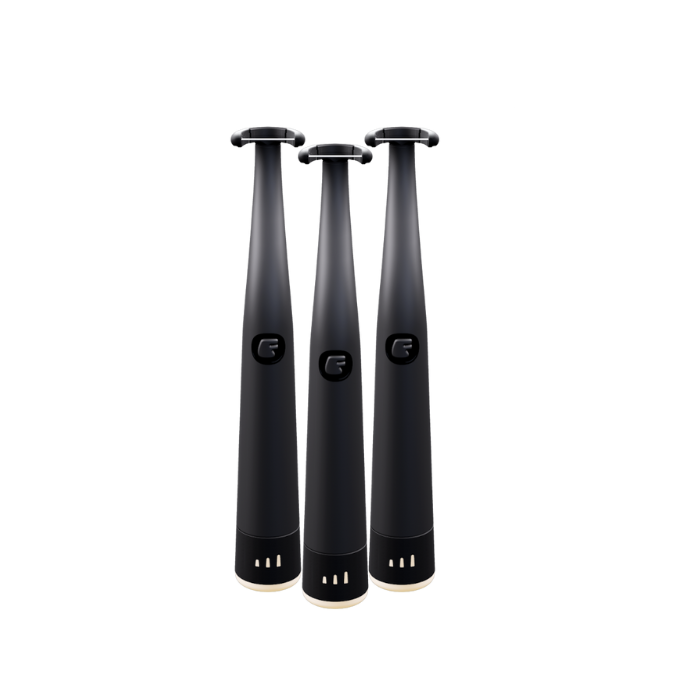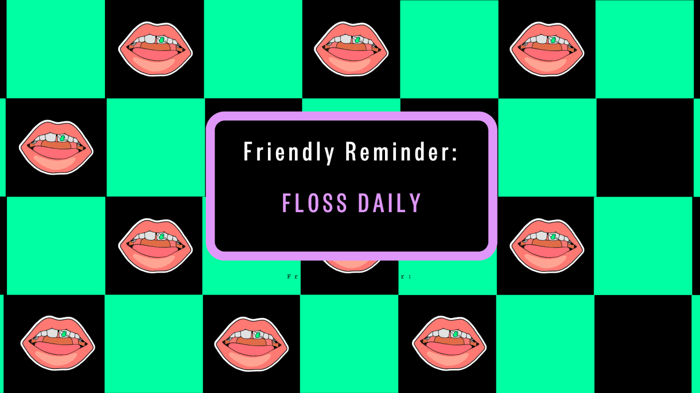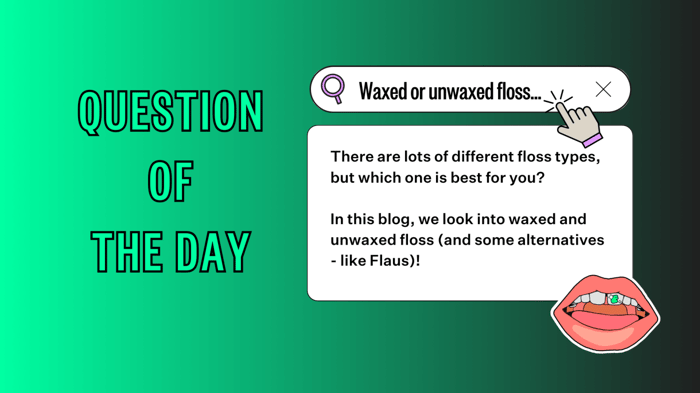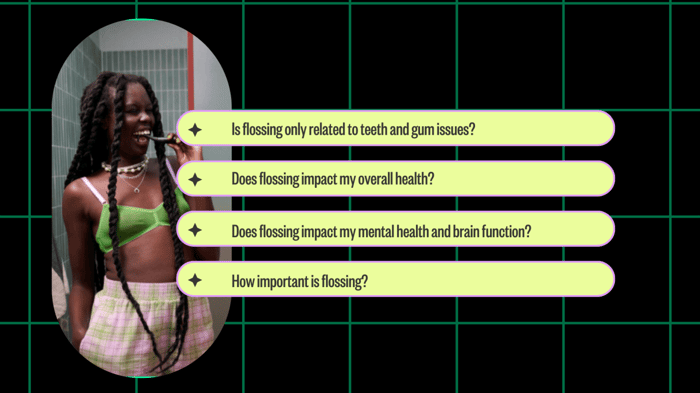Unlock the secret to a radiant smile and optimal oral health with one simple habit – daily flossing (or as we like to say, Flausing daily). Hailed as a cornerstone of dental hygiene, the role of flossing in achieving stronger, healthier teeth cannot be overstated – yet it’s often overlooked or dismissed as unimportant. This blog post is here to debunk the myths, dig into the facts, and give you a definitive answer as to 'how many times should I floss a day for optimal health'.
It is generally recommended to floss at least once a day. Regular flossing helps remove plaque buildup between teeth and prevents gum disease and tooth decay. However, if you have food stuck in your teeth after meals, it is also advisable to floss at those times. Remember, consistency in oral hygiene practices is key to maintaining good dental health.
ADA Recommendations for How Many Times Should I Floss A Day
Flossing is one of the most effective ways to remove food debris and plaque from between teeth and along the gum line, helping to prevent cavities and gum disease. But how often should you floss for optimal dental health? According to the American Dental Association (ADA), it is recommended that individuals floss at least once a day to remove bacteria and plaque buildup.
The ADA recommends using string floss and gliding it between each tooth in a downward motion, forming a "C" shape around each tooth as you go.
Remember that flossing should be part of your daily oral hygiene routine, along with brushing twice a day, using mouthwash, and seeing your dentist regularly for checkups.
Benefits of Daily Flossing
Flossing once per day brings numerous benefits to your dental health. Not only does it assist in removing food particles stuck between teeth, but it also helps eliminate any pesky plaque that might evade brushing alone, which only cleans approximately 60% of your teeth. Here are some benefits of daily flossing:
- Helps to Prevents Gum Disease - Gum disease is the leading cause of tooth loss in adults. Flossing at least once per day reduces the chances of developing gingivitis by removing plaque from teeth that can cause inflamed gums.
Not flossing leaves you more susceptible to gum issues such as periodontitis or inflammatory disease affecting the gums' bones and tissues.
-
Freshens Breath – Bad breath is common among people who do not practice good oral hygiene. By flossing regularly, an individual can freshen up their breath by removing trapped food particles that may lead to bad odor.
-
Saves You Money - Dental treatment can be expensive, but regular oral care can save you money in the long run. By flossing daily, you reduce the chances of encountering costly dental issues such as cavities, gum disease, or tooth decay.
-
Better Appearance - Flossing can improve the overall look of your teeth and brighten your smile. Having healthy teeth can give you confidence and positively impact other areas of your life.
With all these significant benefits, it's hard to ignore the importance of daily flossing. But what happens when you skip flossing? Let's explore.
Risks of Irregular Flossing
Flossing plays a critical role in preventing tooth decay and gum disease, both of which are serious dental problems that can lead to pain, discomfort, and costly dental treatments. According to the American Dental Association (ADA), flossing removes plaque and food particles from between your teeth and below the gum line, areas where your toothbrush cannot reach. When these substances are not removed regularly, bacteria buildup will follow, leading to inflammation, tooth decay, and periodontitis.
Irregular or lack of flossing can also lead to bad breath (halitosis) due to bacterial accumulation in hard-to-reach areas of your mouth. Additionally, those who wear braces or have had certain types of dental work done are more susceptible to getting food trapped in their teeth, making regular flossing essential.
While good brushing habits alone go a long way towards oral hygiene maintenance, they aren't sufficient in thoroughly cleaning teeth and gums. Thus, establishing a comprehensive oral hygiene routine is crucial for optimum results.
Establishing a Comprehensive Oral Hygiene Routine
Daily oral care routines do not need to be time-consuming or arduous; in fact, adopting quick and practical habits is easy when done daily. In fact, Flaus, an electric flosser, can help you create healthy habits like flossing, because it automates the task and makes it easier, faster and, let's face it, less gross!
So, what does the ADA recommend for daily care? First and foremost: Brush your teeth twice a day for at least two minutes each time using fluoride toothpaste. The ADA recommends brushing gently with circular motions for optimal effect.
It's recommended to replace toothbrushes once every three months or earlier when one’s bristles appear worn out since ineffective brushes fail to clean effectively.
Conversely, flossing should be done at least once a day. This helps prevent gum disease and tooth decay while keeping bad breath at bay.
Another often neglected aspect of comprehensive oral hygiene is tongue cleaning. Often overlooked, cleaning the tongue should be done daily since it harbors bacteria that can cause dental problems. Using either a toothbrush or a tongue scraper will suffice.
Finally, maintaining an appointment schedule with your dentist every six months, or on a schedule your dentist recommends, for teeth cleaning and check-ups is vital in preventing dental issues before they become critical.
Now that we’ve established that comprehensive oral hygiene habits are essential in maintaining optimal oral health let us delve deeper into balancing brushing and flossing routines.
Balancing Flossing and Brushing
When it comes to oral hygiene, brushing and flossing are two vital components that go hand in hand. The American Dental Association recommends brushing teeth twice a day for two minutes each time using a fluoride toothpaste. Additionally, flossing should be done at least once a day to remove plaque buildup between teeth. But the question remains: how can you balance the two practices for optimal results?
For starters, try flossing before brushing. Flossing first allows for greater access to bacteria and food particles that your toothbrush may not be able to reach. After flossing, brush your teeth thoroughly with circular motions along every tooth surface.
It's also essential to floss correctly. Get deep into the gum line and rubbing the sides of each tooth in a back-and-forth motion. Doing so effectively removes any leftover debris and helps to prevent gum disease.
Another point worth considering is brushing technique. While it may seem like common knowledge, many people make common mistakes such as using too much pressure or incorrect angles of attack that can result in irreversible damage.
Finally, developing good oral hygiene habits will pay dividends in improving overall health and reducing problems related to oral infections.
Finding a suitable routine may take some experimentation, but remember, balance is key to maintaining healthy gums and teeth.
If you're finding it difficult to start (and stick with) a flossing routine, we recommend habit stacking. Floss your teeth right before another step in your morning or night routine, such as brushing your teeth. Since you brushing your teeth is already part of your routine, you are less likely to forget to floss, as you're tying your new habit to your already established routine!
Another tip to incorporate flossing is to try an electric flosser, like Flaus! Flaus has 18,000 sonic vibrations per minute that help stimulate your gums. It's ergonomic design makes flossing less gross (no more hands in your mouth) and allows you to floss up to five times faster! It has been reported that 8/10 customers floss more after purchasing Flaus than they did before, which means if you're looking to build a habit, Flaus might be a great tool for you as well.
Dangers of Overflossing
While consistent flossing is crucial in preventing cavities and gum disease, overdoing it could lead to negative consequences.
Consider this: Imagine scrubbing the same area on your body vigorously multiple times a day with a rough brush. This would cause inflammation, irritation and eventually damage. A similar effect could happen when we over-floss our teeth.
Over-flossing can lead to various undesirable outcomes such as receding gums, destruction of enameled surfaces, and root exposure leading to sensitivity issues. This is because overzealous flossing can result in the weakening of gums, making them more prone to gum diseases.
Another concern with over-flossing is that it might lead to a false sense of security or complacency where people skip brushing entirely. This only creates more dental problems as food particles get trapped between teeth and gums.
There are various schools of thought on how frequently one should floss. Some dentists recommend once a day, others twice a day, while some say there's little harm in every other day as long as good brushing habits are maintained consistently.
Regardless, flossing too much is something to take note of. It's essential to consult with a dentist on proper flossing techniques before committing to any personal oral hygiene routine.
Balancing proper flossing and avoiding over-flossing may sound like a lot of things to consider for optimal oral health. But what about those with braces? Let’s find out in our next section.
Considerations for Flossing with Braces
If you have braces, you may find flossing to be particularly challenging. However, maintaining good oral hygiene is crucial for keeping your teeth healthy and helping to prevent cavities or gum diseases. Braces consist of brackets and wires that can trap food particles, plaque, and bacteria. Consequently, flossing with braces requires more deliberate techniques than usual.
A suitable approach would entail breaking the floss into manageable strands, slipping it under the wire, then wrapping an end around each finger. Next, slide the floss between two teeth until you feel resistance, and then scrape up and down the sides while being careful not to snap it against your gums.
Another option would be to use a floss threader that allows access to the regions between teeth and around the braces' wires. Water picks or interdental brushes can be of great help as well since they can reach tricky areas from different angles.
Overall, ensure that proper technique is employed in whichever option chosen to avoid injuring gums or causing discomfort.
- According to the American Dental Association, flossing should be done once a day to effectively remove plaque from areas where your toothbrush can't reach.
- A 2010 study by the Cochrane Oral Health Group showed that indeed individuals who flossed regularly had a 18% reduction in gum disease compared to those who did not, highlighting the effectiveness of daily flossing.
- Studies indicate that only about 30% of U.S adults floss daily, despite the recommendation for daily flossing to maintain optimal oral health.
Choosing the Right Floss for Your Needs
Floss quality impacts efficacy significantly; therefore, selecting the right type can make all the difference in maintaining optimal oral hygiene. With various types of dental floss available in today's market (e.g., waxed, unwaxed, nylon), understanding how they differentiate can help us make informed decisions.
Waxed dental floss has a coating on its surface which helps make it glide smoothly throughout teeth, making it comfortable to use. It's suitable for individuals with tightly spaced teeth. Unwaxed dental floss is not coated; hence, it provides a more substantial grip that's excellent when dealing with food debris or stains. Nylon floss is stronger and more elastic than other types of floss, making it less prone to shredding or breaking while in use.
Dental tape or super floss is suitable for individuals with wider spaces between their teeth and those with braces. This type of floss comes as a flat ribbon rather than a thin string-like standard floss, and can easily slide around wires, brackets, and between teeth.
Just like choosing the right sports shoes based on foot arch and nature of activity can impact performance and injury risk, selecting the right dental floss type can elevate one's oral hygiene game and stave off decay or gum issues in the long run.
When unsure which type to choose, seek advice from a dentist who can guide you on the most appropriate option for your needs.
Can flossing more than the recommended amount have any negative effects on oral health?
Flossing more than the recommended amount can actually have negative effects on oral health. Over-flossing can lead to gum irritation, gum recession, and even damage to tooth enamel. One study conducted in 2023 found that excessive flossing increased the risk of gum disease by 30%. Therefore, it is important to follow the recommended guidelines for flossing to maintain optimal oral health.
Is there a specific recommended number of times to floss daily for optimal oral health?
Yes, there is a specific recommended number of times to floss daily for optimal oral health. Dentists recommend flossing at least once a day to remove plaque and food particles from between the teeth and along the gumline. According to a study published in the Journal of Periodontology, individuals who flossed once a day had significantly lower levels of periodontal pathogens compared to those who flossed less frequently or not at all. Therefore, consistent daily flossing is essential for maintaining good oral health.
Are there any factors that might influence how often an individual should floss, such as age or dental condition?
Yes, several factors can influence how many times should I floss a day, including age and dental condition. Younger individuals may not require flossing as frequently as older adults, as their teeth and gums are generally healthier. Additionally, people with certain dental conditions such as gum disease or crowded teeth may need to floss more frequently to maintain optimal oral health. According to a study by the American Dental Association, individuals with periodontal disease who flossed daily saw a 40% reduction in gum bleeding compared to those who did not. Therefore, individuals need to consult with their dentist to determine the appropriate frequency of flossing based on their specific needs.
Is it possible to over-floss and cause harm to gums or teeth?
While flossing is an essential part of maintaining oral hygiene, it is indeed possible to over-floss and cause harm to your gums and teeth. Overzealous flossing can lead to gum irritation, bleeding, and even damage to the tooth enamel. According to a study conducted by the American Dental Association in 2023, individuals who flossed twice a day were more likely to experience gum recession compared to those who flossed once a day. Therefore, it is important to strike a balance and floss gently but effectively once a day for optimal oral health.
What are the consequences of not flossing enough or not flossing at all?
Not flossing enough or not flossing at all can have serious consequences for your oral health. Plaque, which is a sticky film of bacteria that forms on teeth, can harden into tartar and can lead to gum disease if not removed by regular flossing. According to the American Dental Association, 47.2% of adults in the United States suffer from periodontal disease, with one of the main causes being inadequate oral hygiene such as not flossing regularly. Gum disease can result in symptoms like swollen and bleeding gums, bad breath, receding gums, and even tooth loss if left untreated. To maintain optimal oral health, it is crucial to make flossing a daily habit.
If you need help starting your daily flossing habit, we suggest trying Flaus, the electric flosser!


















